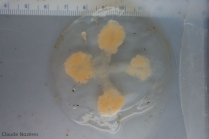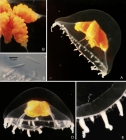RAS taxon details
Ptychogena A. Agassiz, 1865
117143 (urn:lsid:marinespecies.org:taxname:117143)
accepted
Genus
marine, brackish, fresh, terrestrial
recent only
Agassiz, A. (1865). North American Acalephae. <em>Illustrated Catalogue of the Museum of Comparative Zoölogy at Harvard College.</em> 2: 1-234., available online at http://www.biodiversitylibrary.org/bibliography/1837
page(s): 137 [details]
page(s): 137 [details]
Schuchert, P. (2021). World Hydrozoa Database. Ptychogena A. Agassiz, 1865. Accessed through: RAS (Eds.) (2021) Register of Antarctic Species at: http://ras.biodiversity.aq/aphia.php?p=taxdetails&id=117143 on 2025-09-13
RAS (Eds.) (2025). Register of Antarctic Species. Ptychogena A. Agassiz, 1865. Accessed at: https://ras.biodiversity.aq/aphia.php?p=taxdetails&id=117143 on 2025-09-13
Date
action
by
original description
Agassiz, A. (1865). North American Acalephae. <em>Illustrated Catalogue of the Museum of Comparative Zoölogy at Harvard College.</em> 2: 1-234., available online at http://www.biodiversitylibrary.org/bibliography/1837
page(s): 137 [details]
basis of record van der Land, J.; Vervoort, W.; Cairns, S.D.; Schuchert, P. (2001). Hydrozoa, <B><I>in</I></B>: Costello, M.J. <i>et al.</i> (Ed.) (2001). <i>European register of marine species: a check-list of the marine species in Europe and a bibliography of guides to their identification. Collection Patrimoines Naturels,</i> 50: pp. 112-120 (look up in IMIS) [details]
redescription Schuchert P., Hosia A., Leclère L. (2017). Identification of the polyp stage of three leptomedusa species using DNA barcoding. <em>Revue suisse de Zoologie.</em> 124(1): 167-182., available online at https://bioone.org/journals/revue-suisse-de-zoologie/volume-124/issue-1/zenodo.322675/Identification-of-the-polyp-stage-of-three-leptomedusa-species-using/10.5281/zenodo.322675.full
note: polyp stage [details]
page(s): 137 [details]
basis of record van der Land, J.; Vervoort, W.; Cairns, S.D.; Schuchert, P. (2001). Hydrozoa, <B><I>in</I></B>: Costello, M.J. <i>et al.</i> (Ed.) (2001). <i>European register of marine species: a check-list of the marine species in Europe and a bibliography of guides to their identification. Collection Patrimoines Naturels,</i> 50: pp. 112-120 (look up in IMIS) [details]
redescription Schuchert P., Hosia A., Leclère L. (2017). Identification of the polyp stage of three leptomedusa species using DNA barcoding. <em>Revue suisse de Zoologie.</em> 124(1): 167-182., available online at https://bioone.org/journals/revue-suisse-de-zoologie/volume-124/issue-1/zenodo.322675/Identification-of-the-polyp-stage-of-three-leptomedusa-species-using/10.5281/zenodo.322675.full
note: polyp stage [details]
 Present
Present  Inaccurate
Inaccurate  Introduced: alien
Introduced: alien  Containing type locality
Containing type locality

